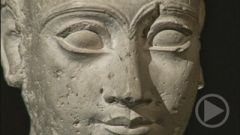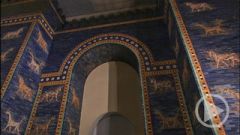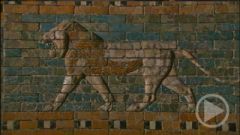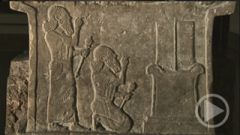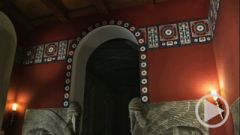- Home
- »
- Germany
- »
- Berlin
- »
- Museum Island
- »
- Pergamon Museum
- »
- The Museum of the Ancient Near East
- »
- The Pergamon Museum - Power and Doom of the Assyrians
Power and Doom of the Assyrians
Power and Doom of the Assyrians
In 1910, Walter Andrae's team of diggers found a lot of small basalt fragments in the atrium of the temple at Ashur. Once again, restorers were faced with a large scale jigsaw puzzle and no picture to use for clues. They systematically studied each fragment, carefully piecing together the figures and filling in missing bits, until finally they were looking at a small archaeological sensation: a square basin the sides of which are a study of the element of water.
At the upper edge of the picture, streams of bubbling water pour from open vessels. In the middle of the sides, the streams run together into the hands of gods and then flow to the ground. In the corners stand gods with water containers - we can recognise them by their horned crowns. The gods are framed by priests who hold small buckets in their hands.
For a long time, it was believed their robes were modelled on fish. Then it was discovered that there was a species of fish in the Euphrates that could grow as large as a man. The priests actually donned their skins, so their heads poked out of the mouths of real fish. We don't know exactly what the basin was used for. The few bits of writing that have survived say only that King Sennacherib ordered it built. But the basin is further impressive evidence that water was at the centre of Mesopotamian life. Generous rainfall and clever irrigation systems made the land extremely fertile.
And it was that basis that allowed Assyrian political might to grow. Their power is evidenced by this stele found in Zincirli in eastern Turkey. That was the site of the late Hittite city-state of Samal. The Assyrians subjugated it - and the stele never let the Hittites forget to whom they were subject.
"Whoever shall remove this stele from its location, erase my written name and write his own in its place, may Ishtar, the goddess of war and battle, make his manhood female and let him sit bound at the feet of his enemies."
It was King Esarhaddon who had that rather drastic threat chiselled on the stele. He conquered Syria and Palestine and, in 671 B.C., defeated the Egyptian pharaoh Taharqa. The stele was erected to glorify that victory.
On the front, we see Esarhaddon kitted out in his full royal robes. Next to his head are various symbols of gods and devotional images. Two defeated rulers kneel in front of the king. In order to stress Esarhaddon's authority, he is portrayed much larger than the subjugated princes - a typical technique at the time, referred to as "perspective of meaning". To further humiliate his enemies, Esarhaddon is leading them like oxen on rings through their noses, or even their lips. The clothing of the two prisoners suggests that the one in front might be the son of pharaoh Taharqa and the one in back perhaps the Syrian ruler Baal of Tyre.
In 608 B.C. less than two generations after that triumph, the last Assyrian king died. A bare 60 years later, Babylon also fell. The great civilisations of Mesopotamia had come to an end.


